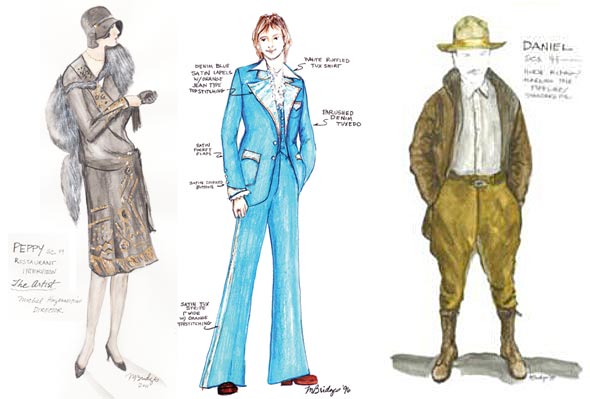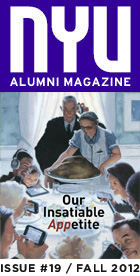film
The Clothes Make
the Man
Costume designer Mark Bridges fashions characters one garment at a time
by Renée Alfuso / CAS ’06
When Melissa Leo first saw her wardrobe for The Fighter—hangers of tight tops, short skirts, and flashy blazers with big shoulder pads circa the early 1990s—the veteran character actress was skeptical. But once they were on, Leo soon transformed into the gruff and ferocious mother of nine who would later earn her an Academy Award. “Suddenly it all came together and a third person emerged in the fitting room,” costume designer Mark Bridges (TSOA ’87) recalls. “When we started, there had only been the two of us, and then her Alice Ward appeared.”
Tasked with bringing the people on the page to life, Bridges searches for a character nearly as deeply as the actor does, making his job as much about anthropology as it is about fashion. His detective work goes far beyond costume shops. Whether it’s the 1927 Sears catalog, a faded photo album, or a vintage GQ spread, Bridges uses all manner of resources to illustrate the story for the director before shooting even begins. His specialty is period films and, having tackled nearly every decade of the past century, he’s become an expert on bygone eras and their smallest details (a deco collar here, an aged campaign hat there). So it’s fitting that after more than 20 years of telling stories through clothing, Bridges won an Oscar earlier this year for Best Achievement in Costume Design on perhaps the most challenging period piece in decades—The Artist.
When Bridges took the stage and thanked the Academy “for making a lifelong dream come true,” he meant it literally. As a kid growing up in Niagara Falls, he spent a lot of time at the movies to escape the long, icy winters of Western New York’s snowbelt and fell in love with silent films at a local revival theater. “I just became really fascinated at an early age,” he says. “I still have a book report from seventh grade that I did on silent-movie actors [like] Chaplin and Douglas Fairbanks.”
For a film fanatic who also loved drawing, painting, and fabrics, costuming proved a natural fit. He’d grown up watching his grandmother sew and began making his own Halloween costumes around age 9. “It’s really a job that combines everything I was naturally good at or drawn to,” he says. After earning an MFA in costume design from the Tisch School of the Arts, Bridges got his big break in 1988 on the Coen Brothers Prohibition-era drama Miller’s Crossing. He was hired for just a few days of sizing clothes, but his hard work prompted costume designer Richard Hornung to keep Bridges as his assistant for the duration of the shoot—as well as eight more films after that, including The Grifters, Barton Fink, and Nixon.
But it was Bridges’ love of classic cinema that helped land him the most important film of his career. In a preliminary meeting with director Michel Hazanavicius, the designer referenced the 1928 comedic gem Show People, which happened to be the very film that had inspired Hazanavicius to write The Artist—last year’s silent, black-and-white tribute to the Golden Age of Hollywood. The concept was a gamble, but Bridges believed in it from the start: “I thought, in this time when film so heavily relies on CGI and 3-D, maybe what we really need is to get back to basics, and to telling a story instead of whipping everybody into a frenzy with all these other gadgets.”
The old-fashioned format, however, came with some unusual filmmaking challenges. Most fabric patterns looked like mush in black and white, so Bridges used sequins, satins, brocades, and spangles to catch the light and compensate for the lack of color and definition. These adjustments were essential, Bridges says, on a film stripped of dialogue. “It’s like if a person loses their sight, their other senses become more acute,” he explains. “Once you didn’t have the language, then you became more aware of all the visuals. So between texture and contrast, that’s how we told a story without any words.”
The film opens with leading man George Valentin in stark black-and-white tails at the height of his fame, but the suits fade to a more gray value as his career plummets with the arrival of talkies. Meanwhile fresh-faced dancer Peppy Miller starts out simple and sweet in flat textured dresses that become more elaborate and luxurious with her rise as Hollywood’s hottest new starlet. By the end, Peppy dons an extraordinary black coat trimmed in monkey fur, a surviving piece from the 1920s that, along with the hats and background clothes, Bridges discovered in a Los Angeles costume shop. “One of the first things I do is go put my hands on clothing, just trying to find actual garments to inspire me,” says Bridges, who then scours thrift shops once he’s on location. “You won’t even be looking for things or know that you’re looking—you’ll just stumble upon it and it will turn out to be one of the greatest finds.”
Although the ladies’ silk gowns and Bond-girl bikinis get most of the attention, Bridges relishes the challenge of menswear. The less-versatile medium forces him to be extra creative, such as with the bright-blue suit Adam Sandler wears throughout all of Punch-Drunk Love, and Johnny Depp’s white safari jacket and ribbed turtleneck ensemble in Blow. The latter film’s 1970s chic earned Bridges praise from Vogue: “It’s the clothes…that really make Blow worth watching.”
Bridges searches for a character nearly as deeply as the actor does, making his job as much about anthropology as it is about fashion.
But not all shoots can be glamour and vintage Yves Saint Laurent. The turn-of-the-century oil drama There Will Be Blood was filmed in the West Texas desert without any stores or FedEx on hand, so Bridges instructed his crew to “prepare like we’re going to Gilligan’s Island,” because they would be limited to whatever supplies they had. The unforgiving set was hot, dusty, and crawling with rattlesnakes, but Bridges toughed it out with faith in his fearless leader, Paul Thomas Anderson. Over the past 17 years, Bridges has designed every one of the writer-director’s films, developing a relationship based on mutual trust. “I remember getting a phone call before Blood and he said, ‘Mark, I need to know what my movie’s gonna look like,’ ” Bridges says.
Their latest collaboration is the 1950s drama The Master, which stars Joaquin Phoenix as a World War II vet named Freddie, who is drawn to a charismatic thinker in the mold of L. Ron Hubbard, played by Philip Seymour Hoffman (TSOA ’89). To prepare for it, Bridges searched for candid family photos from 1950 to, as he says, “get the feel of what regular people really looked like—not Hollywood’s or Madison Avenue’s version of America.” The challenge is to make the clothes seem natural despite all the effort that goes into them. As Bridges puts it, “If you don’t notice my work then I’ve done a good job, because I haven’t taken you out of the moment, I’ve only enhanced your experience.”







